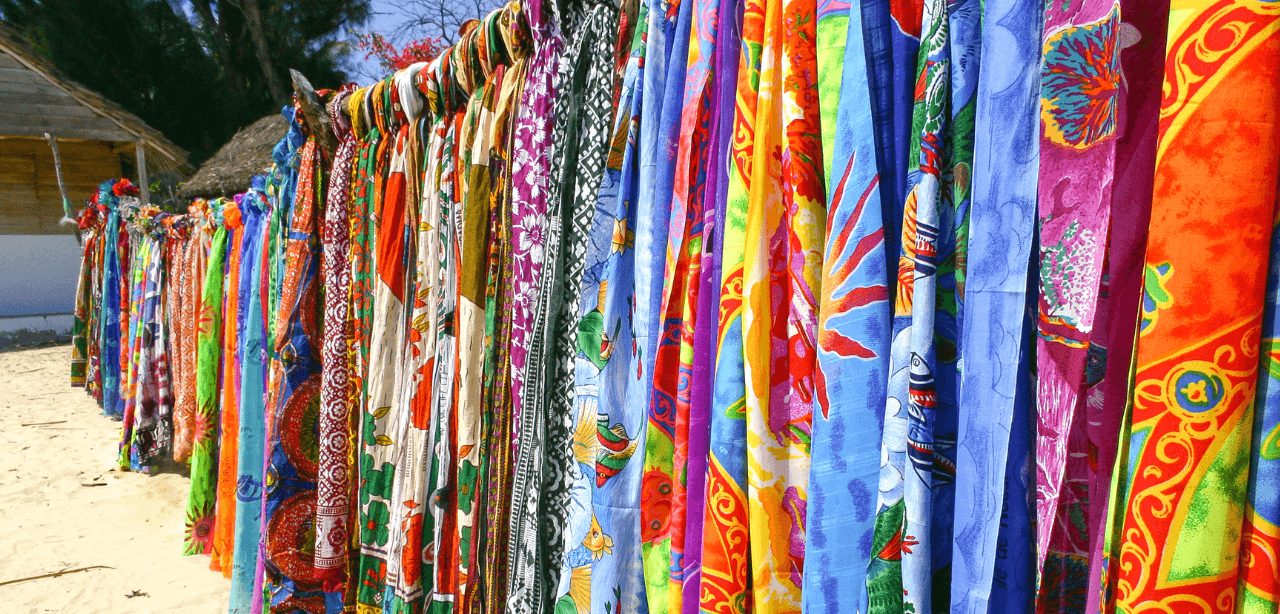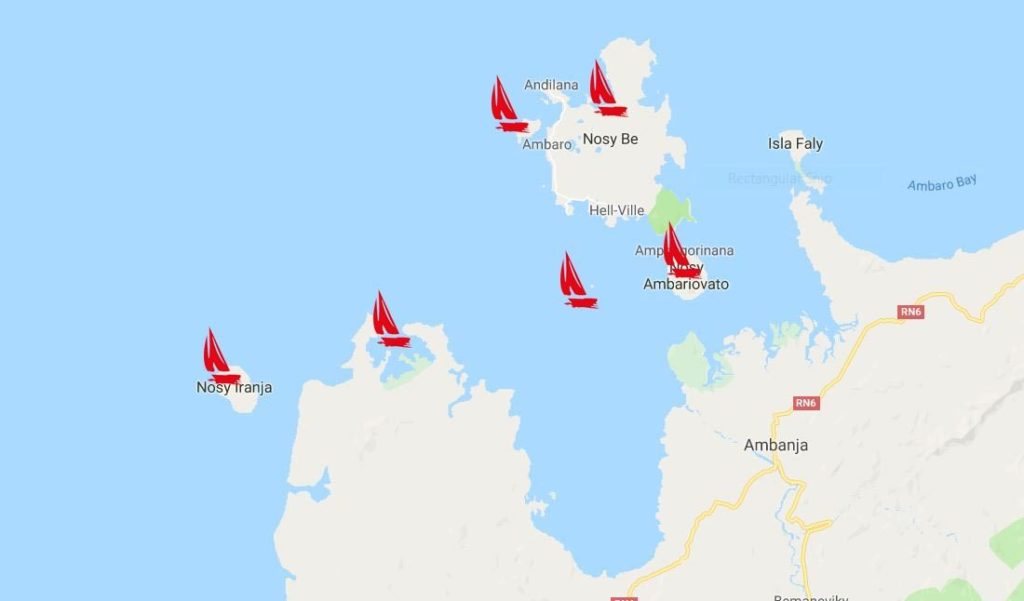Discover Madagascar with our essential sailing guide

Madagascar is an island located off the southeast coast of Africa and is often referred to as a world in one country due to its vast biodiversity. Thanks to the country’s proactive approach to wildlife conservation and preservation, Madagascar is home to some of the world’s most endangered species of animal, including the cute and cuddly looking lemurs and is a hotspot for travellers looking to mix the usual holiday delights of sun, sea and sand with culture, wildlife and environment.
The mainland of Madagascar is surrounded by lots of quaint islands that all have their own charm, and as such, offers some spectacular sailing for those looking for a bareboat yacht charter somewhere a little unusual. Wind streams are very inviting but there are a number of prohibited areas, so the conditions lend themselves to experienced sailors looking for an exhilarating nautical adventure.
With so much to see and do, we’ve pulled together a suggested list of the islands and places to visit while on a sailing holiday to Madagascar to help you plan the perfect itinerary.

Madagascar hasn’t always been an island and was once connected to the mainland of Africa.
Our top five places to visit when sailing Madagascar
1. Nosy Be
Located off the north coast of mainland Madagascar is Nosy Be, home to the Locamarine, where your yacht charter will be based from. Head to the Lokobe Special Reserve, located on the south east corner of the island, and visit the last remaining lowland forest area, along with black lemurs and the rare panther chameleon.
On the north of the island you’ll come to Andilana Beach, one of the most beautiful beaches in the world. With soft white sand, clear turquoise waters and towering palm trees, the beach is a perfect place for a spot of snorkelling and diving, where you’ll likely see a range of colourful fish, turtles and coral before heading on land for a romantic walk along the shore as the sun sets.

There are over 100 different species of lemur living on Madagascar.
2. Nosy Sakatia
Situated off the west coast of Nosy Be is Nosy Sakatia, affectionately referred to as the ‘Island of the Orchid’. The island is home to a flourishing ecosystem which welcomes visitors, with beautiful sights and sensual aromas. Full of rich flora and fauna, the island is the perfect place to enjoy nature in all its glory, and a hike to the centre is highly recommended to take advantage of that.
Take your time to visit all corners of the island, where you’ll be greeted by the friendly locals as you pass through the many villages, orchid and vanilla plantations and perhaps come face to face with a friendly lemur on one of the forest trails before dining on the beach with your feet in the water.
 Photo by Ferenc Horvath
Photo by Ferenc Horvath
Over 70% of the wildlife found in Madagascar can’t be found anywhere else in the world.
3. Nosy Iranja
Connected by a 2km white sandbar are the two islets that make up Nosy Iranja – Nosy Iranja Be and Nosy Iranja Kely. The epitome of paradise, the pure white beaches and glistening turquoise sea are an inviting welcome to all who sail to this delightful island and swimming and diving are a must, where you’ll be surrounded by vibrantly coloured fish, rays and sea turtles, and if you are really lucky, you might even catch sight of the rare Omura’s whale, which is indigenous to the area.
The island is well known for its passionate approach to the conservation of sea turtles and visitors should make sure they take some time to visit the Hawksbill Turtle Reserve, where the delicate ecosystem is the perfect environment for the turtles to lay their eggs and if you’re lucky, you may even see some turtle babies hatch.
 Vanilla flower
Vanilla flower
Madagascar exports more than half of the world’s Vanilla trade and is one of the largest sapphire suppliers!
4. Nosy Tanikely
Off the south coast of Nosy Be, sail to Nosy Tanikely, home to some exceptional rainforest, full of lush vegetation and endangered species of wildlife. The island is also a National Marine Reserve and the protected waters are an excellent place to see some of the breathtaking sea life, from giant sea turtles to a mass of colourful coral.
On land, marvel at the spectacular view from the island’s lighthouse, where you’ll see a vast span of ocean to one side and a dense jungle on the other. Make friends with ring-tailed lemur and at night, see some of the fruit bats that inhabit the island.

Madagascar is home to the third largest coral reef in the world.
5. – Nosy Komba
Last, but by no means least, take a day to explore the island of Nosy Komba, full of excitement and adventure and a wonderful place to spend some time in a laid back atmosphere surrounded by superb wildlife. Watch as local fisherman take their giant nets out to sea to catch their dinner and stop by one of the small huts that line the beach, where local woman make crafts that are perfect for souvenirs to take home.
The island is full of winding rivers which culminate into cascading waterfalls, each with their own pools of fresh, clean water, ideal for a quick dip as you take a wander through the forests. Swap your yacht for a more traditional form of transport and take an hour to sail around the shore in a traditional Malagasy canoe, built for wood collected from the mountains on the island.
 Fisherman in a traditional canoe
Fisherman in a traditional canoe
Even though Madagascar is twice the size of the UK, it only has the equivalent of 1% of our built roads.
Top five places to eat and drink in Madagascar
- Pily Pily Restaurant, Andilana Resort, Nosy Be – Situated on the beach with breathtaking views out over Andilana Bay, the Pily Pily Restaurant offers mouthwatering cuisine in a beautiful setting with the option to upgrade and enjoy your meal on a private terrace overlooking the water. Dishes include freshly caught seafood and local meats and are cooked with accompanying ingredients sourced from the island, including vanilla and jackfruit.
- Ristorante la Spraggia by Andilana, Nosy Iranja – Located on the white sandy beaches of Nosy Iranja, the Ristorante la Spraggia is a cosy eatery with excellent views and quality flavours. All the food is freshly prepared by the head chef and his team and includes an array of freshly caught fish and local meats. We recommend the seafood spaghetti or the Zebu skewers.
- Le Papillon, Nosy Be – With an excellent cocktail and wine menu it won’t be just the food that excites you at Le Papillon on Nosy Be. The restaurant, which has won a ‘TripAdvisor Certificate of Excellence’ for the last three years, serves a range of tasty cuisine with a Mediterranean undercurrent. For a real treat, try the Foie Gras or fish tartare.
- Ilo Village, Nosy Komba – If you’re looking for a restaurant and bar with a laid back, party atmosphere, pay a visit to Ilo Village on Nosy Komba. This lovely little gem is located on the beach and run by patrons, John and Sophie, who will be happy to welcome you. Try one of the delicious pizzas and ‘Sophie’s special Mojito’
- Chez Tantine, Nosy Be – For a real taste of Madagascar, pay a visit to Chez Tantine, where there are no frills and no fancies, just flavoursome local cuisine. Located in a small hut on the beach, the cafe serves fresh seafood in a Malagasy style and is excellent value for money. Try the freshly caught sea urchin or the calamari and coco rice.
One week Madagascar sailing itinerary
Day 1: Embark your yacht at the Locomarine in Nosy Be
Day 2: Sail from Nosy Be to Nosy Sakatia (8nm) and spend the day on the Island of the Orchids before heading back to Nosy Be to moor overnight
Day 3: Head off early and sail approximately 25nm south from Nosy Be to Nosy Iranja
Day 4: Sail from Nosy Iranja to Baie des Russes where you can enjoy the day at leisure. Spend the afternoon sailing back towards Nosy Be where you can enjoy dinner at one of our recommended restaurants
Day 5: Sail a short passage from Nosy Be to Nosy Komba (7nm)
Day 6: Sail from Nosy Komba to Nosy Tanikely (5nnm)
Day 7: Head back north from Nosy Tanikely towards Nosy Be (3nm) where you can spend some time enjoying the local ambience and cuisine before heading back on board for your last night
Day 8: Disembark

Temperatures in Madagascar
Temperatures are tropical and warm year-round with midday temperatures averaging 85ºF. The winter months are between April and October and are cooler, while the summer months from November to March are hot with variable rainfall and possible monsoons. The best times to visit are between January and March. The south of the island sees the least rain.
Sailing conditions in Madagascar
From October to July, there is an easterly blowing Varatraz wind in the mornings and the westerly Talo wind in the afternoons. From August to September, the Varatraz is dominant throughout the day but is strongest during the afternoon when it can reach 45 knots.. There are two tides each day, from 30cm to 4.5m between high tide and low tide.
Flying to Madagascar
Flights to Madagascar are available from London Gatwick Airport (LGW) and most regional airports via Charles de Gaulle Airport (CDG) or Frankfurt Airport (FRA) with British Airways and other low cost airlines and then on to Antananarivo Airport (TNR) in Madagascar, where you can then take a connecting internal flight Nosy Be Fascene Airport (NOS). Transfers from Fascene Airport to the Locamarine via taxi take around 45-mins and can be booked in advance. Speak to us if you would like help arranging your transfer.
Get in touch
If you want to know more about sailing in Madagascar speak to one of our experts who will be happy to share their knowledge with you. Use our price comparison tool to search for charters by date or destination, request a quote or contact our team on 01227 479 900.
2019-02-26 07:42:19.000


